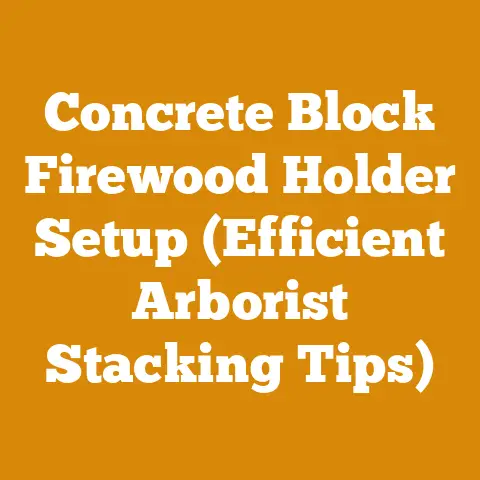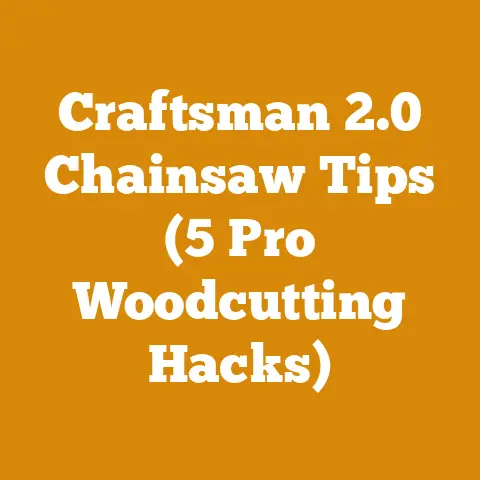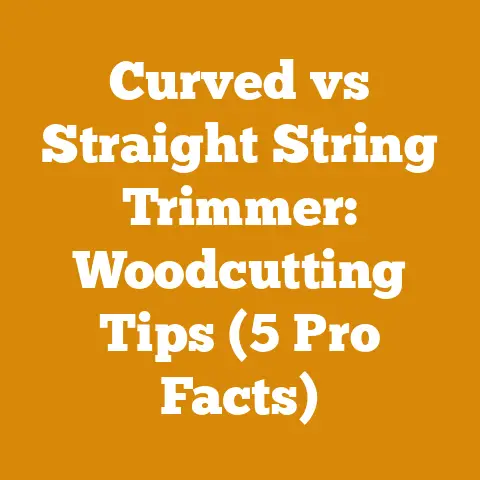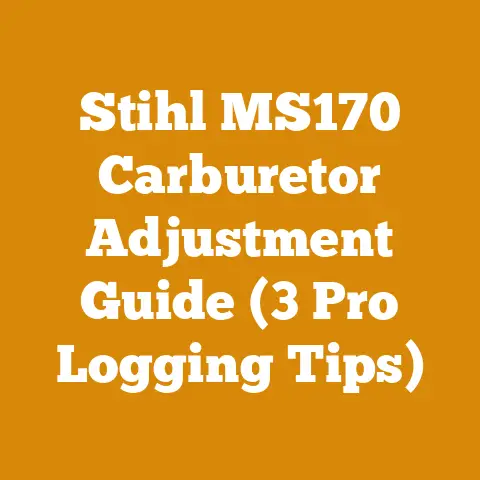How Soon After Stump Grinding Can You Plant? (5 Pro Insights)
Understanding the Stump Grinding Aftermath
The Immediate Post-Grinding Environment
After a stump is ground, you’re left with a mixture of wood chips and soil.
This isn’t exactly the fertile ground you might imagine.
The process of stump grinding, while effective at removing the visible stump, creates an environment that is temporarily imbalanced.
- Wood Chips: The primary component is, of course, wood chips.
These are essentially raw organic material that will eventually decompose. - Soil Disruption: The grinding process also disturbs the surrounding soil, affecting its structure and nutrient availability.
- Potential Contaminants: Depending on the history of the tree, there might be lingering pathogens or fungi in the wood chips.
Decomposition: The Key Process
Decomposition is the natural process where microorganisms break down organic matter.
In the context of stump grinding, this means the wood chips are being converted into simpler compounds.
This is essential for creating a plant-friendly environment.
- Nitrogen Drawdown: As wood chips decompose, they consume nitrogen from the soil.
This is a critical point because nitrogen is a vital nutrient for plant growth.
If you plant too soon, your new plants might struggle due to nitrogen deficiency. - Decomposition Rate Factors: Several factors influence how quickly wood chips decompose:
- Wood Type: Hardwoods (like oak or maple) decompose slower than softwoods (like pine or fir).
- Chip Size: Smaller chips decompose faster because they have a larger surface area exposed to microorganisms.
- Moisture: Adequate moisture is crucial for microbial activity.
- Temperature: Warmer temperatures accelerate decomposition.
- Data Point: A study published in the “Journal of Environmental Quality” found that hardwood chips can take up to two years to fully decompose in temperate climates, while softwood chips may decompose in as little as one year.
This highlights the importance of knowing what type of tree was ground.
Assessing the Soil
Before even thinking about planting, I always advocate for assessing the soil.
It’s like a doctor taking a patient’s vitals before prescribing medication.
Why This Works
- Reduces Nitrogen Drawdown: The waiting period gives the wood chips time to start breaking down, reducing the immediate nitrogen demand.
- Improves Soil Structure: As the chips decompose, they improve soil structure by adding organic matter.
- Minimizes Pathogen Risk: Time helps to reduce the risk of any lingering pathogens affecting new plants.
Practical Steps
- Remove Excess Chips: Shovel away as many of the larger wood chips as possible.
This is especially important if you’re dealing with hardwood chips.
Aim to remove at least the top 4-6 inches of chips. - Incorporate Remaining Chips: Mix the remaining chips with the existing soil.
This helps to aerate the soil and improve drainage. - Water Regularly: Keep the area consistently moist to encourage decomposition.
- Monitor for Weeds: Weed seeds often germinate in disturbed soil.
Regularly remove any weeds that sprout.
Case Study: My Own Fruit Tree Planting
Several years ago, I had a large oak stump ground in my backyard.
I was eager to plant a fruit tree in its place.
Following my own advice, I waited six months, removing as many chips as possible and regularly watering the area.
When I finally planted the tree, it thrived.
Had I rushed the process, I’m confident the tree would have struggled.
Pro Insight #2: Soil Amendments: Your Best Friend
Soil amendments are materials added to the soil to improve its physical and chemical properties.
They are crucial for counteracting the negative effects of stump grinding.
Types of Amendments
- Compost: Compost is decomposed organic matter that is rich in nutrients and beneficial microorganisms.
It’s my go-to amendment for almost any soil issue. - Manure: Aged manure is another excellent source of nutrients.
Make sure it’s well-composted to avoid burning plant roots. - Nitrogen Fertilizer: Adding a nitrogen fertilizer can help to offset the nitrogen drawdown caused by wood chip decomposition.
Use a slow-release fertilizer to avoid over-fertilizing. - Topsoil: If the soil is severely disturbed, consider adding a layer of high-quality topsoil.
- Mycorrhizae Inoculant: Mycorrhizae are beneficial fungi that form symbiotic relationships with plant roots, helping them to absorb nutrients and water.
Adding a mycorrhizae inoculant can give your plants a boost.
Application Rates
- Compost: Apply a 2-4 inch layer of compost over the area and mix it into the top 6-8 inches of soil.
- Manure: Apply a 1-2 inch layer of aged manure and mix it into the soil.
- Nitrogen Fertilizer: Follow the instructions on the fertilizer packaging.
A general rule of thumb is to apply about 1 pound of nitrogen per 100 square feet. - Topsoil: Add enough topsoil to bring the soil level back to its original height.
- Mycorrhizae Inoculant: Sprinkle the inoculant over the roots of the plants at planting time.
Data Point: Compost Benefits
A study published by the USDA found that adding compost to soil can increase plant growth by up to 50%.
This is due to the improved nutrient availability, water retention, and soil structure.
Technical Requirement: Compost Specifications
When selecting compost, pay attention to these specifications:
- Carbon-to-Nitrogen Ratio (C:N): A C:N ratio of 20:1 or lower is ideal.
This indicates that the compost is well-decomposed and will release nutrients readily. - Moisture Content: The compost should be moist but not soggy.
Aim for a moisture content of around 40-60%. - Particle Size: The compost should have a fine to medium particle size.
Avoid compost with large chunks of undecomposed material. - Pathogen Content: Ensure the compost has been properly composted to kill any pathogens.
Selecting the right plants is crucial for success.Pioneer Species
Pioneer species are plants that are well-adapted to colonizing disturbed areas.
They are often fast-growing and tolerant of poor soil conditions.- Examples:
- Grasses: Many types of grasses are excellent pioneer species.
They help to stabilize the soil and prevent erosion. - Legumes: Legumes (like clover and alfalfa) are nitrogen-fixing plants, meaning they can convert atmospheric nitrogen into a form that plants can use.
This makes them ideal for improving soil fertility. - Wildflowers: Many wildflowers are adapted to poor soil conditions and can add beauty to the landscape.
- Grasses: Many types of grasses are excellent pioneer species.
Adaptable Species
These plants aren’t necessarily pioneers but are known for their ability to thrive in a variety of soil conditions.
- Examples:
- Daylilies: Daylilies are tough and adaptable perennials that can tolerate a wide range of soil conditions.
- Hostas: Hostas are shade-loving plants that are relatively tolerant of poor soil.
- Coneflowers: Coneflowers are drought-tolerant perennials that can thrive in well-drained soil.
What to Avoid Initially
Avoid planting plants that are highly sensitive to soil conditions, such as:
- Roses: Roses are notoriously finicky and require rich, well-drained soil.
- Azaleas: Azaleas prefer acidic soil and may struggle in alkaline conditions.
- Blueberries: Blueberries also require acidic soil and may not thrive in recently disturbed areas.
Technical Specifications: Root Depth
Consider the root depth of the plants you choose.
Shallow-rooted plants are more likely to be affected by the surface layer of wood chips, while deep-rooted plants can access nutrients and water from deeper in the soil.- Shallow-Rooted Plants: Plants with roots that extend less than 12 inches deep.
- Deep-Rooted Plants: Plants with roots that extend more than 12 inches deep.
Pro Insight #4: The “Lasagna Gardening” Technique: Layering for Success
Lasagna gardening, also known as sheet composting, is a no-dig gardening method that involves layering organic materials to create a rich, fertile planting bed.
It’s particularly useful for areas where the soil is poor or disturbed, like after stump grinding.How It Works
The basic principle is to layer “brown” materials (carbon-rich) and “green” materials (nitrogen-rich) like you’re making a lasagna.
Over time, these layers decompose and create a nutrient-rich planting bed.Materials You’ll Need
- Cardboard or Newspaper: This forms the base layer and smothers any existing grass or weeds.
- Brown Materials:
- Dry leaves
- Straw
- Shredded paper
- Wood chips (use sparingly, especially hardwood)
- Green Materials:
- Grass clippings
- Vegetable scraps
- Coffee grounds
- Manure
- Compost: This is the “cheese” of the lasagna and adds a boost of nutrients.
- Topsoil: A final layer of topsoil provides a planting surface.
Steps
- Lay Down Cardboard: Cover the area with cardboard or newspaper, overlapping the edges to prevent weeds from growing through.
Wet the cardboard thoroughly. - Layer Brown and Green Materials: Alternate layers of brown and green materials, making each layer 2-4 inches thick.
Moisten each layer as you go. - Add Compost: Spread a 2-4 inch layer of compost over the top.
- Top with Topsoil: Add a 2-4 inch layer of topsoil.
- Wait: Allow the lasagna bed to decompose for at least a few weeks before planting.
The longer you wait, the better.
Technical Tip: Cardboard Preparation
Before using cardboard, remove any tape or labels.
Avoid using glossy cardboard, as it can contain inks that are harmful to plants.Case Study: Revitalizing a Logging Site
I once worked on a project to revitalize a small logging site that had been heavily disturbed.
We used the lasagna gardening technique to create planting beds for native trees and shrubs.
The results were remarkable.
The plants thrived in the nutrient-rich soil, and the site quickly recovered.Pro Insight #5: Container Gardening: A Quick and Easy Solution
If you’re impatient or want to avoid dealing with the complexities of soil amendment, container gardening is a great option.
Benefits
- Control Over Soil: You have complete control over the soil composition in the container.
- Portability: You can easily move the plants around as needed.
- No Soil Disturbance: You don’t have to worry about disturbing the existing soil.
Choosing the Right Containers
- Size: Choose containers that are large enough to accommodate the mature size of the plants.
- Material: Containers can be made from a variety of materials, including plastic, terracotta, and wood.
- Drainage: Make sure the containers have adequate drainage holes.
Soil Mix
Use a high-quality potting mix that is specifically formulated for container gardening.
Avoid using garden soil, as it can become compacted in containers.Planting
Plant the plants in the containers according to the instructions on the plant labels.
Maintenance
Water the plants regularly and fertilize them as needed.
Technical Specification: Container Drainage
Ensure that the drainage holes in your containers are at least 0.5 inches in diameter.
This will prevent water from pooling in the bottom of the container and causing root rot.
You can also add a layer of gravel or broken pottery to the bottom of the container to improve drainage.Addressing Specific Concerns
Potential for Tree Diseases
If the tree that was ground down was diseased, there is a risk that the disease could spread to new plants.
- Identification: If you know the tree was diseased, try to identify the specific disease.
- Prevention:
- Remove as many of the wood chips as possible.
- Treat the soil with a fungicide.
- Choose disease-resistant plants.
- Consultation: Consult with a local arborist or plant pathologist for advice on how to manage the disease.
Termite Activity
Stump grinding can sometimes attract termites to the area.
- Prevention:
- Remove as many of the wood chips as possible.
- Treat the soil with a termiticide.
- Keep mulch away from the foundation of your home.
- Monitoring: Regularly inspect the area for signs of termite activity.
Safety Considerations
- Wear appropriate personal protective equipment (PPE) when handling wood chips and soil. This includes gloves, eye protection, and a dust mask.
- Be careful when digging in the area, as there may be buried roots or rocks.
- Avoid using heavy machinery on the area until the soil has had time to settle.
Conclusion: Patience and Preparation Are Key
Planting after stump grinding isn’t an immediate process, but with patience, preparation, and the right approach, you can create a thriving garden or landscape.
Remember to assess your soil, amend it appropriately, choose the right plants, and consider techniques like lasagna gardening or container gardening.
By following these pro insights, you’ll be well on your way to transforming that stump-filled space into something beautiful and productive.
Good luck, and happy planting! - Examples:






